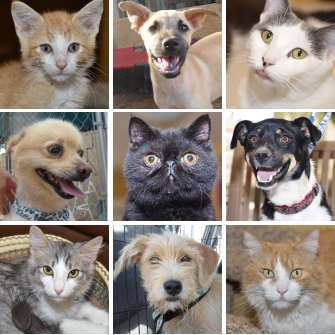Bringing Doggie Home
Tips for Transitioning Your New Dog to Resident Pets
If you already have a pet or pets as part of your household, it’s important to know the best way to introduce your new canine to his housemates. When it’s time for your new dog or puppy to meet your current dog or cat, make sure you closely supervise the big event.
Looking for Pet Friendly Housing?
If you are interested in adopting but in need of pet-friendly housing or for those who have adopted but in need of new housing, we’ve put together a few resources:
- Glendale (Zillow)
Pet-friendly listings with fair rental price estimates - Glendale (Trulia)
Apartments with pet-friendly filters and in-depth neighborhood information - Glendale (Hotpads)
Pet-friendly filters and in-depth photos, information and unique features such as street view of each property - Phoenix (Zillow)
Pet-friendly listings with fair rental price estimates - Phoenix (Trulia)
Phoenix Apartments with pet-friendly filters and in-depth neighborhood information - Phoenix (Hotpads)
Phoenix Apartments page with pet-friendly filters, in-depth photos, information and unique features such as street view of each property - Arizona (Zillow)
Pet-friendly listings with fair rental price estimates
Introducing your new dog to a resident dog
Keep both animals on leashes, and bring along a second person to help. It’s best if the dogs can meet on neutral territory— such as a park or friend’s house, or outside the home. Ideally dogs should meet prior to an adoption to ensure basic compatibility, but remember it takes time to forge a friendship.
To start, let the dogs sniff each other briefly, keeping them leashed. Speak in positive, happy tones. If they seem agitated, redirect their energy by taking them separately for short walks and let them investigate other areas. Reward them for obeying a simple command, like “sit” or “stay.” And don’t forget to maintain a positive demeanor. Dogs are very sensitive to our energies, and if they sense you are anxious, they’re far more likely to be anxious themselves. Keep a careful eye on the dogs’ body language. If you see signs of hostility—snarling or growling, baring teeth, tucked and/or raised tail, raised fur on nape of neck, flattened ears—quickly separate and redirect them.
Once the dogs have gotten accustomed to each other, it’s time to head home. If your resident dog still seems to show any signs of aggression, put the new dog in a crate and give your older one a lot of positive attention for a while. Ignore the new dog for a bit to reassure your pet that the new guy isn’t a replacement!
Once your older dog seems calm and reassured, let him near the crate for a visit. Continue to praise him for good behavior and give him lots of attention. When it’s time to let the pets meet nose to nose again, keep them on loose leashes, so you can separate them if need be.
Always feed them separately and give them their own toys (they’re not kids, so don’t expect them to share well). Do not leave dogs and highly desirable treats (like bones) together unsupervised. This often causes fighting called “resource guarding” even between dogs who know each other well. They should also have separate sleeping areas until you are 100% certain they are okay together.
Pack walks are essential to the physical and mental health of your dogs. Taking a daily walk together provides the best opportunity for humans, the resident dog and the new dog to bond together. Even if it is a short walk, try to take a walk together every day. Trips to the dog park are a good way to socialize, but not a substitute for walking. Make sure your dogs are all up to date on their shots (adults need an annual booster and puppies need a series of three vaccinations before they can go out in public) before going outside home territory. Playing games such as fetch, frisbee or swimming is also a good way to get exercise and a fun way for the family to get involved. In the heat of summer, exercise in the morning or at dusk, and be mindful of the heat of the pavement on your dogs’ paws. Watch for signs of heat exhaustion, such as excessive panting, difficulty breathing, bright red mucous membranes in the mouth/tongue, and thick saliva. Dogs with short snouts cannot tolerate heat or heavy exercise as well as other breeds. If you notice these signs, move the dog to a cooler place immediately, offer small amounts of water, wet the dog with cool water on the head, neck, paw pads and the stomach area, and seek medical help if the dog’s temperature is over 104 degrees.
Introducing your new dog to your resident cat
Step 1: Choose the proper location for the first meeting
Resident cat to new dog: If you are adopting a dog, you should not take your cat to meet him at a shelter, or other establishment which houses a number of animals for health and safety reasons. Instead, the introduction should take place at home.
Step 2: Separate the animals
Across a few days, rotate which animal has freedom and which is confined to allow each animal plenty of time to investigate the other one’s scent.
Sometimes the dog should be confined to a crate or another room (or taken to another location if he can’t be left alone) to allow the cat time to roam free and investigate the smell of the dog.
If the dog obsessively digs at the separation barrier or barks at the cat for more than a day or two, the interaction likely won’t work without proper training. You may need the help of a professional.
When no one is home, the dog or cat must always be securely confined so unsupervised interactions are not possible.
Once the dog is calm (or at least not obsessed with the cat) and the cat is calm, eating and using the litter box normally, you can proceed to the next step.
Step 3: Make leashed introductions
If there is any fear or aggression displayed on either animal’s part, stay at step 2 longer. Continue indefinitely until both the dog and cat seem happy and relaxed around each other.
When no one is home, the dog or cat should be securely confined to separate areas so unsupervised interactions are not possible.
Step 4: Allow unsupervised interactions
Unsupervised time together can occur after the cat and dog have been supervised around each other for a significant period of time (a month or so) and you are positive they will not hurt each other.
Warning Signs
If the dog remains overly focused, does not take his eyes off the cat or the door, completely ignores you or lunges suddenly as soon as the cat moves, this is probably a dangerous match. If you are looking for a dog for your resident cat, try another dog. If this is your dog, you should probably not get him a cat.
If at any time the dog lunges toward, growls, snaps at or shows any aggression toward a calm, quiet, still cat, this match will probably not work out. The same holds true if a cat attacks a calm, quiet dog. If you are committed to make the relationship work, you will probably need a professional at this point.




